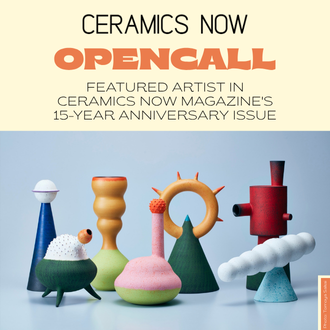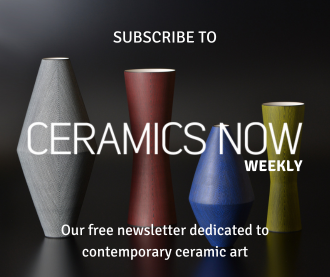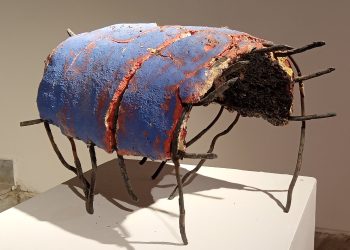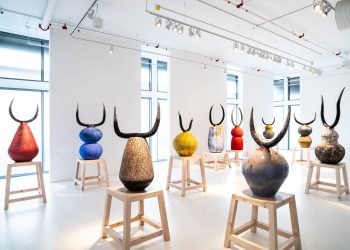By Monica Monaia
“I am human because I belong.”
Archbishop Desmond Tutu
South Africa, with its rich diversity of ethnicities, is often seen as a place of cultural convergence. Art, in its many forms, holds a significant place in the country’s cultural landscape. It is also home to a vibrant community of ceramicists, where traditional and contemporary practices intersect in dynamic ways. The art of ceramics is particularly celebrated through various events that bring together an eclectic group of artists, showcasing their work and highlighting the depth of talent within the field.
Despite this rich artistic environment, the full diversity of South Africa’s ceramic community is not always equally reflected across all spaces. While many Black artists are nationally and internationally recognized, questions remain about access, visibility, and structural equity, especially for Black and Multiracial ceramicists.1 This article reflects on the evolving dynamics of representation in South African ceramics, drawing from personal interviews and recent initiatives aimed at bridging past and present.
Historical Context: Apartheid and Its Legacy
To fully grasp the current underrepresentation of Black and Multiracial ceramicists, it is essential to examine South Africa’s past. The apartheid regime (1948–1994) systematically reinforced racial segregation, restricting access to education, economic opportunities, and artistic development for non-white communities. The ceramic arts were no exception—Black and Multiracial artists were largely excluded from formal training, with creative pursuits often confined to functional crafts rather than recognized as fine art.
Art education during Apartheid reflected these broader inequalities. While white students had access to institutions that nurtured creativity and artistic experimentation, Black and Multiracial students were steered toward vocational training with limited resources. The fine arts were framed through a Eurocentric lens, dismissing indigenous artistic traditions as ethnographic rather than innovative or expressive. (Watts, 2020)2
The work of Black ceramicists has often been overlooked in mainstream art history, relegated to footnotes or anthropological studies rather than being recognized as integral to South Africa’s artistic evolution. This historical neglect underscores the imbalance in documentation. Early records failed to capture the cultural and personal significance of their work. As Ruth Simbao notes in her paper Self-Identification as Resistance: Visual Constructions of ‘Africanness’ and ‘Blackness’ During Apartheid, “Even up until the early 1990s, the works of black South African artists that referenced Africa were often framed in terms of anachronistic, regressive traditionalism”. The Eurocentric bias of mainstream art institutions, combined with the dominance of white curators, writers, and dealers, meant that portrayals of ‘Africanness’ often revealed more about ‘whiteness’ than about any authentic experience of ‘blackness’ or ‘Africanness.’ (Simbao, 41)3






Despite these barriers, certain institutions provided crucial spaces for Black artists to develop their skills. The Polly Street Art Centre in Johannesburg and the Evangelical Lutheran Church (ELC) Centre for Art and Craft at Rorke’s Drift in KwaZulu-Natal were among the few places where Black artists could access training. These spaces not only fostered artistic growth but also allowed for the blending of traditional African ceramic techniques with contemporary influences, laying the groundwork for a new wave of South African ceramicists.
Beyond formal institutions, community art centres played a pivotal role in nurturing artistic talent, particularly in underserved areas. These centres provided access to training, materials, and mentorship. Apprenticeships and in-service training programs, though limited in scope, offered vocational pathways into ceramics, equipping individuals with the technical expertise needed for employment and economic independence. Community-based ceramics projects further strengthened cultural identity and pride, enabling artists to engage with traditional techniques while adapting them to contemporary contexts. These initiatives not only preserved heritage but also empowered local communities by fostering economic self-sufficiency through ceramic production.
While these systemic barriers created deep-rooted challenges, the post-apartheid era has also seen significant progress, with institutions expanding access to education and many artists from previously marginalized backgrounds gaining national and international success.
With the fall of Apartheid in 1994, South Africa’s art landscape began to shift. Racial barriers to education and exhibition spaces were formally lifted, allowing more Black and Multiracial artists to enter the field. However, the legacy of exclusion persisted. Many ceramics programs were discontinued due to financial constraints, and the field struggled to regain prominence within the country’s broader artistic discourse. As a result, many Black and Multiracial ceramicists had to rely on community-based workshops, self-teaching, or mentorship to develop their craft. (Watts, 2020)
Today, the impact of apartheid-era exclusion is still evident. While South Africa’s contemporary ceramics scene is growing in diversity, structural inequalities continue to shape access to resources, gallery representation, and market opportunities. Recognizing and addressing these historical imbalances is key to fostering a more inclusive and representative ceramics industry.
The Art-Craft Divide
One of the most significant challenges faced by South African ceramicists is the persistent art-craft divide. This distinction, rooted in colonial-era values, often relegates ceramics to the realm of craft rather than art. As Ronnie Watt’s research, A Contextual History of South African Ceramics of the Twentieth and Twenty-first Centuries highlights, this divide has historically marginalized the work of Black and Multiracial ceramicists, whose creations were often viewed as functional or ethnographic rather than as fine art. (Watts, 2020)
This marginalization is not unique to South African ceramics but resonates with broader historical trends in the study of African art. Throughout the twentieth century, art institutions and publications often positioned African ceramics as artifacts of cultural heritage rather than as contemporary artistic expressions. This distinction reinforced the perception that Black artists were merely preserving tradition rather than actively shaping the future of South African ceramics.
Lorenzo Fiorucci, Art Historian and Director of the Contemporary Ceramic Art Museum in Torgiano, Italy, underscores this point by noting that “for many years, African artistic artifacts were primarily studied within the realms of anthropology, ethnology, ethnomusicology or archaeology, rather than being recognized as subjects of art historical inquiry” (own translation). This perspective, rooted in a positivist and cataloguing mindset, categorized African objects as functional or devotional rather than artistic, reflecting a wider pattern of marginalization.


This approach began to shift when “Black art” became a source of inspiration for prominent artists like Picasso and Matisse. Interestingly, this appeared even in artists such as De Chirico, helping to introduce the Western world to the notion that these artifacts held artistic significance beyond their original contexts. However, African communities themselves, with some exceptions, may not have fully embraced the idea that these objects could transcend their sacred or functional purposes, often overlooking their potential historical and artistic value.
“In recent decades, there has been a marked transformation. Art historians now pay closer attention to the connections between African art and other artistic movements, particularly those of the twentieth century. Additionally, platforms such as the Venice Biennale have increasingly highlighted African art in its most recent editions. This reflects a growing acknowledgment of the importance of integrating a field that was, for far too long, relegated solely to anthropological study.” (Fiorucci, 2025, own translation)4
However, as Fiorucci cautions, the art world must still contend with the dominance of market-driven values, which often prioritize economic considerations over artistic expression.
In this context, Karabo Morule’s efforts with Capital Art are particularly significant. As the founder of the first art collection management platform focused on African art, Morule aims to transform the perception of African art from mere artifacts to valuable cultural and financial assets. Her vision is to ensure that contemporary African artwork is recognized for its long-term value, both for artists and collectors. The perception of African art being marginalized and often considered craft has contributed to a lack of local collectors who view art as an asset class. As Morule notes, art should be seen as a generational legacy, passed down through time, and not just as a commodity for the wealthy. By advocating for the preservation of heritage and the elevation of African art as a bankable asset class, Morule is helping to reshape the narrative around African artistic contributions and their place in the global art market. (Morule, 2023)5
The Contemporary Ceramics Scene
Contemporary ceramicists across South Africa face a wide range of challenges, but the legacy of past exclusions can still affect visibility, particularly for emerging Black and Multiracial artists, who often navigate limited access to resources and the lingering weight of historical narratives.
Sandile B. Cele, ceramic artist from Fish Hoek near Cape Town, sheds light on the difficulties that many artists face. The financial burden of creating ceramic pieces and the costs associated with participating in exhibitions—such as participation fees and freight costs—are high for less privileged artists. Even when artists manage to exhibit their work, the lack of sales can result in financial losses, discouraging participation in future opportunities. This financial strain often forces artists to prioritize selling their work over creative exploration, which can relegate their creations to the realm of craft rather than art.
Without the backing of art galleries that promote their work, the lack of networking opportunities and exposure often hinders the visibility and growth of Black and Multiracial ceramic artists in South Africa. (Cele, 2024)6
At the same time, others working within South Africa’s ceramics community emphasize that significant strides have been made in the past decades. Formal education is now more widely accessible, with financial support available for previously disadvantaged artists, and some of the country’s most successful ceramicists today are Black artists.
Jenny Chadwick, ceramic artist and chair of Ceramics Southern Africa Western Cape Region, highlights several key barriers preventing Black and Multiracial artists from achieving full representation and recognition today. Systemic and contextual obstacles—rooted in the legacy of Apartheid—continue to hinder progress. Limited access to education and training, coupled with the challenges of business and home ownership, disproportionately affect Black and Multiracial artists, making it harder to establish themselves in the industry.





Market perceptions further exacerbate the problem. There is a persistent bias regarding what constitutes “authentic” art from Black and Multiracial artists, often restricting their creative freedom. This bias not only limits their ability to explore diverse artistic expressions but also perpetuates a narrow and often reductive view of their work.
However, organizations like Ceramics Southern Africa (CSA) play a crucial role in addressing these disparities. As Jenny Chadwick notes, her tenure as the CSA Western Cape regional chair has focused on fostering inclusivity and growth in what has historically been a predominantly white collective. Initiatives under her leadership include:
• Nominating Black and Multiracial ceramic artists to serve on the committee.
• Mindfully selecting exhibition locations and judges to ensure diversity.
• Assisting with trading, membership, and exhibition fees to reduce financial barriers.
• Providing platforms for trade, exhibitions, and workshops for members.
• Featuring interviews and conversations with Black and Multiracial ceramic artists in newsletters.
• Launching the Skills Shares Project (2024) and the internship project (2022).
These efforts are vital in creating a more equitable and supportive environment for Black and Multiracial ceramicists to thrive and gain recognition. (Chadwick, 2024-2025)7
Moreover, there are art galleries that actively support and promote the work of Black artists. One such gallery is Southern Guild, based in Cape Town, South Africa, which has positioned itself as a leading platform for showcasing African design and artistry on a global stage.
The gallery’s philosophy highlights Africa’s vital role in the global art world. Lindsey Raymond, director of Southern Guild, emphasizes that “Africa is not isolated—the whole world has passed through the continent!” Their mission is to introduce African art to international audiences while showcasing the continent’s enduring influence and relevance. With a foundation in African culture and a global outlook, Southern Guild redefines how African art is perceived worldwide.
Raymond describes the selection process, noting that many represented artists are self-taught with unique styles and intuitive techniques. The gallery prioritizes artists who value material exploration and the preservation of craft traditions. When discussing the integration of African artistic traditions into contemporary art, she stresses the importance of authenticity: “Traditions, cultures, and ceremonies of importance are not rarefied practices that become commonplace and lose their ability to shape a person.” She believes that artists must express their experiences to evoke emotion and discovery.
Raymond acknowledges the challenges in achieving diverse representation and emphasizes the gallery’s commitment to addressing historical imbalances. To foster inclusivity, Southern Guild prioritizes extensive solo exhibitions that encourage deeper engagement with contemporary artists. The gallery provides financial and logistical support for ceramic artists, helping them secure studio spaces, apply for international residencies, and cover production costs. Nevertheless, Raymond notes that further efforts are needed to nurture and support Multiracial artists in South Africa and beyond. (Raymond, 2025)8
Among the institutions that play a crucial role in shaping the South African ceramics landscape, the Rust-En-Vrede Gallery and Clay Museum in Durbanville stands as a key promoter of artistic excellence. Through exhibitions and recognition programs, it has provided a platform for emerging and established ceramicists, contributing to the visibility of South African ceramics both nationally and internationally.
The Clay Awards, hosted by the Gallery in November 2024 in its inaugural edition, was one of the most prestigious events in the field, aiming to celebrate artistic innovation and craftsmanship. With a diverse panel of expert judges, including Dame Magdalene Odundo (UK/Kenya), Janet DeBoos (Australia), Prof. Guangzhen Zhou (USA/China), Stanis Mbwanga (Democratic Republic of Congo), Prof. Elizabeth Perrill (USA/Switzerland), Dr. Ronnie Watt (Canada/South Africa), André Hess (UK/South Africa), Andile Dyalvane (South Africa), Digby Hoets (South Africa), and Olivia Barrell (South Africa), the selection process sought to reflect a broad spectrum of talent. However, in this first edition of the award, out of fifty selected candidates, only six were Black, and none were Multiracial. (Clay Awards online catalogue, 2024)9
Despite efforts to foster inclusivity, the representation of Black artists in the selection amounted to 12%, while Multiracial artists were entirely absent. These numbers do not indicate intentional exclusion but rather reflect systemic barriers that continue to hinder equitable access and visibility for historically marginalized artists.
While many praised the Clay Awards for creating a platform that celebrated innovation and diversity, some observers noted the low proportion of Black and Multiracial finalists relative to the country’s demographics. Others view the exhibition as a reflection of current professional opportunities, while acknowledging that structural issues still affect access at earlier stages in artistic careers.
The museum’s role in promoting South African art is undeniable. By hosting the Clay Awards and curating exhibitions, it elevates particular voices and contributes to shaping the country’s artistic identity. However, the underrepresentation of Black and Multiracial artists in such a significant exhibition highlights the ongoing need for intentional efforts to address historical disparities and structural inequities in the field of ceramics.






Steps Toward Inclusion
Despite these challenges, there are signs of progress. Organizations and initiatives dedicated to promoting diversity in the arts are creating opportunities for Black and Multiracial ceramicists to showcase their work. Collaborative projects, mentorship programs, and funding opportunities are helping to slowly level the playing field.
Artists like Sandile B. Cele, Zizipho Poswa, Andile Dyalvane, Madoda Fani, and Chuma Maweni exemplify the potential for South African ceramicists to break through these barriers. Exploring the journeys of these four artists reveals how their unique voices contribute to a vibrant narrative in South African ceramics.
Sandile Brian Cele, (b. 1980, Uumlazi, KwaZulu-Natal) is a ceramic artist known for his innovative fusion of traditional Zulu aesthetics with contemporary Gothic influences. His creative process involves meticulous hand-building techniques, where he shapes clay into intricate forms that reflect his cultural heritage and personal experiences. Cele’s work often features bold, expressive designs, which results in unique pieces. Cele studied Fine Arts at Natal Technikon in 2002. He worked with ART AID in Mpumalanga Township and collaborated with organizations to promote Black South African artists. After refining his skills as a studio assistant to internationally acclaimed ceramic artist Clementina van der Walt, he founded SBC Design Studio in 2016. In 2019, he launched his Zulu Goth line and has since participated in multiple exhibitions nationally and internationally.
Madoda Fani (b. 1975, Cape Town, Western Cape) is a ceramic artist known for his hand-coiled, burnished, and smoke-fired pieces that evolve traditional Nguni ceramics into contemporary forms. He studied graphic design at Sivuyile College and was trained in smoke-firing techniques by Molelekoa Simon Masilo and Nic Sithole, with Jabu Nala introducing him to burnishing. Fani’s sculptural works feature curvaceous organic forms adorned with intricate, scale-like patterns. His major exhibitions include iQweqwe (2021), inspired by insect exoskeletons, and Madoda: Let Us Now Praise Famous Men (2024), which reimagines domestic objects to challenge stereotypes of Black masculinity. His Imbokodo series (2024) honors the resilience of women through five smoke-fired vessels.
Beyond ceramics, Fani explores furniture and bronze sculpture. He has completed residencies in Argentina, France, Austria, Mexico, and Australia and taught at Haystack Mountain School of Crafts (Maine, US) in 2023. A 2022 LOEWE Foundation Craft Prize finalist, his work is held in the Philadelphia Museum of Art, Mint Museum, and private collections, including the LOEWE Foundation and HRH Franz, Duke of Bavaria.
Chuma Maweni (b. 1976, Port Elizabeth, Eastern Cape) is a ceramic artist renowned for his meticulously crafted furniture and vessels. He gained recognition with his teardrop-shaped conical pots, characterized by dark, porous surfaces and traditional Nguni smoke-firing techniques. Maweni’s journey in ceramics began in childhood, shaping clay figures along the Eastern Cape riverbanks, and he later moved to KwaPayne village to focus on his education amid the anti-Apartheid upheaval. He graduated with a Bachelor of Technology in ceramic design from Nelson Mandela Metropolitan University in 2002 and taught ceramics to rural women as part of a poverty alleviation initiative. Relocating to Cape Town in 2006, he worked with the Light From Africa Foundation, mentoring other ceramicists while developing his unique style, eventually opening his studio in 2016.
Maweni’s Imbizo table and stool set, which means “gathering” in isiXhosa, marked a significant milestone in his career, leading to an extensive range of sculptural stools and other furniture pieces recognized with a Design Foundation Award in 2018. His work has been exhibited widely, including at the Metropolitan Museum of Art in New York, and at international events like Expo Chicago, Design Miami, and PAD London. Maweni completed a residency at the Academy of Ceramics Gmunden, Austria, in Summer 2023, and created over 70 unique pieces for the Xigera Safari Lodge in Botswana in 2021. His first solo exhibition, iMvelaphi, featuring his largest collection to date, opened at Southern Guild Cape Town in November 2024.
Andile Dyalvane (b. 1978, Ngobozana, Eastern Cape) is a prominent ceramic artist deeply connected to his Xhosa heritage. His large-scale ceramic artworks serve as metaphorical vessels that honor his cultural traditions and personal healing journey, with clay symbolizing both a life-affirming connection to the earth and a medium for storytelling. He earned a National Diploma in Art and Design from Sivuyile Technical College and a National Diploma in Ceramic Design from Nelson Mandela Metropolitan University in 2003. In 2005, he co-founded Imiso Ceramics with Zizipho Poswa, gaining international acclaim for their handmade tableware, which incorporates incision marks inspired by African body scarification.
Dyalvane’s international solo debut, Camagu (2016), showcased over-scaled ceramic vessels and furniture at Friedman Benda in New York, emphasizing gratitude towards ancestors. His subsequent works, such as Idladla (2017) and iThongo (2020), explore themes of rural life, spirituality, and Xhosa language preservation through innovative sculptural designs. His latest exhibition, OoNomathotholo: Ancestral Whispers (2024), reflects on communal grief while offering perspectives of harmony.
Dyalvane’s work is held in prestigious collections, including the Metropolitan Museum of Art, Pérez Museum, and Denver Art Museum. He has exhibited globally, participated in numerous biennales, and contributed to publications such as Clay Formes and Africanfuturism. As a member of the International Academy of Ceramics, he leads master classes worldwide and has completed residencies at renowned institutions. Dyalvane has received several accolades, including the 2015 Design Foundation Icon Award and a Special Mention in the 2022 LOEWE Foundation Craft Prize.





Zizipho Poswa (b. 1979, Mthatha, Eastern Cape) is a Cape Town-based artist known for her bold ceramic and bronze sculptures celebrating African womanhood. She studied surface design at the Cape Peninsula University of Technology and co-founded Imiso Ceramics in 2005 with Andile Dyalvane, gaining international recognition for their handmade vessels. Her work blends figuration and abstraction, drawing inspiration from Xhosa cultural traditions and personal experiences. Poswa’s solo exhibitions include iLobola (2021), exploring the symbolism of bride-wealth, uBuhle boKhokho (2022), reinterpreting African hairstyles, and iiNtsika zeSizwe (2023), her first bronze sculpture series in the U.S. Her most ambitious project, Indyebo yakwaNtu (2024), debuted at Southern Guild’s Los Angeles gallery, honoring African adornment traditions. Poswa’s work is held in major institutions such as The Met, LACMA, the Philadelphia Museum of Art, and the Art Institute of Chicago. She has exhibited globally, participated in Salone del Mobile 2024, and completed a residency at California State University Long Beach under Tony Marsh.
Conclusion
The underrepresentation of Black and Multiracial ceramicists in South Africa is a complex issue rooted in historical inequities, systemic barriers, and persistent biases. However, the resilience and creativity of these artists, combined with the efforts of supportive institutions and individuals, are paving the way for a more inclusive and equitable ceramics industry.
While the presence of Black ceramicists in South Africa’s art world is increasingly visible, the stories of Multiracial ceramicists remain less documented. This may be due to overlapping identities, systemic erasure, or simply a lack of focused attention, an area that deserves deeper exploration through local collaboration.
To combat the underrepresentation of Black and Multiracial ceramicists, a multifaceted approach is essential. This effort requires collaboration across various sectors of the art community and the implementation of concrete actions, such as:
• Host panel discussions and workshops: Organize events that bring together artists, curators, and collectors to discuss representation, challenges, and solutions in the ceramic arts.
• Promote collaborations: Encourage partnerships between established artists and underrepresented ceramicists to facilitate mentorship, skill-sharing, and greater visibility for emerging voices.
• Advocate for inclusive curatorial practices: Urge institutions to adopt curatorial practices that prioritize diversity and ensure that Black and Multiracial artists are represented in exhibitions and collections.
• Engage with communities: Actively connect with local communities to identify and support ceramicists who may not yet be widely recognized, providing them with opportunities for exposure and growth.
By implementing these strategies, we can work collectively towards a more equitable art world that recognizes and celebrates the diverse voices within the ceramic arts community.
The power of art lies in its ability to shape visibility, challenge narratives, and create spaces for belonging. As we continue to navigate this journey, let us honour the work of those who have come before, support the artists of today, and inspire the visionaries of tomorrow.
Editor’s Note: This article reflects on representation and access in South African ceramics, drawing on personal interviews and historical context. While it acknowledges significant progress since the end of Apartheid, it also highlights ongoing challenges. We welcome further perspectives from the South African ceramics community as part of an ongoing conversation.
Monica Monaia is an emerging ceramic artist whose work spans between South Africa and Italy. With a background in Theology, she writes about culture, identity, and ceramics, exploring the intersections of heritage, personal experience, and creative expression. Her artistic practice is deeply influenced by her mixed Italian and Ethiopian heritage, and she engages with themes of belonging, visibility, and the role of ceramics in shaping cultural narratives. Monica has participated in various exhibitions, including the Ceramics Southern Africa Regional in 2024 and Tazzinart 2024 in Italy. She recently curated and presented the Tazzinart exhibition in Cape Town, promoting a cultural bridge between Italian and South African ceramic artists, focusing on giving visibility to less privileged and renowned artists.
Subscribe to Ceramics Now to read similar articles, essays, reviews and critical reflections on contemporary ceramics. Subscriptions help us feature a wider range of voices, perspectives, and expertise in the ceramics community.
Footnotes
- South Africa has historically been structured along racial lines into Black, White, Coloured, and Indian/Asian. These classifications were established and enforced under the apartheid regime as a means of institutionalizing racial segregation and control. The term ‘Coloured’ is referred to people with mixed heritage and is still in use today. In this paper, I have chosen to use the term ‘Multiracial’ instead of ‘Coloured’ to distance myself from a label historically used by the apartheid regime.
- Watts, R. (2020). A Contextual History of South African Ceramics of the Twentieth and Twenty-first Centuries (Doctoral dissertation). University of South Africa
- Simbao, R. 2011. Self-identification as resistance. Visual constructions of ‘Africanness’ and ‘blackness’ during apartheid, in Visual Century: South African Art in Context 1907 – 2007, Vol 3, 1973–1992, edited by M Pissarra. Johannesburg: Wits University Press:38–5
- Fiorucci, Lorenzo. Personal Interview. Interview by Monica Monaia, 28 January 2025. Translated by Monica Monaia.
- Morule, K. 2023, 9 March 2023. ETL Speaker Series: Karabo Morule, Capital Art [Video]. YouTube.
- Cele, Sandile B. Personal Interview. Interview by Monica Monaia, 21 December 2024.
- Chadwick, Jenny. Personal Interview. Interview by Monica Monaia, 14 December 2024; 20 January 2025.
- Raymond, Lindsey. Personal Interview. Interview by Monica Monaia, 20 & 30 January 2025.
- South African Clay Awards. (2024). Clay awards 2024 online catalogue.


















